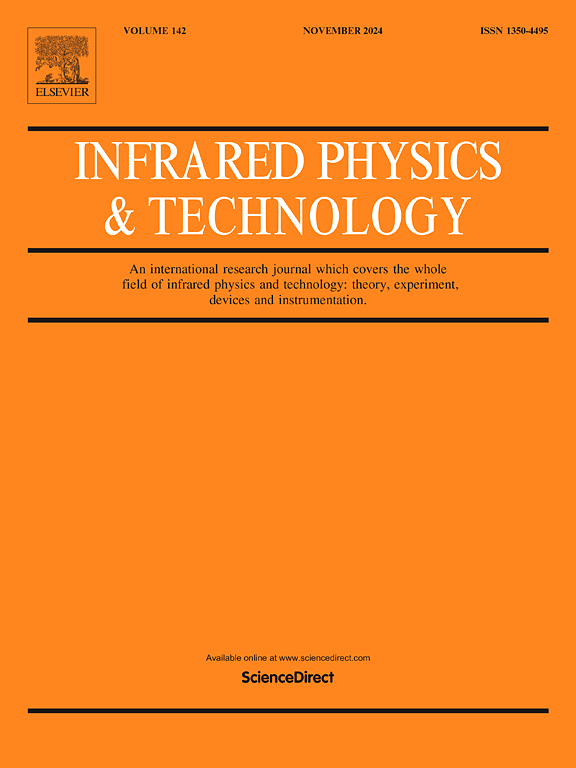红外多探测器非均匀性图像仿真方法
IF 3.1
3区 物理与天体物理
Q2 INSTRUMENTS & INSTRUMENTATION
引用次数: 0
摘要
随着航天技术的飞速发展,对宽视场、高分辨率红外探测系统的需求日益增加。焦平面尺寸已经从厘米级发展到亚米级,单个探测器的尺寸已经不能满足要求。因此,多探测器的镶嵌集成是必然的趋势。多探测器拼接的图像处理研究需要从尽可能多的探测器获取原始图像。然而,由于成本的限制,基于有限数量的探测器图像数据来模拟大量图像是至关重要的。本文对现有的单探测器原始图像模拟方法进行了改进。通过建立像素响应函数模型系数之间的相关性,与现有方法相比,单探测器图像的模拟与实际数据更加接近。同时,在参数生成过程中考虑了读出电路通道的排列特性,使模拟图像在视觉上更接近真实图像。此外,本文还提出了一种基于对同一批次有限数量探测器的真实数据进行分析的方法来模拟任意数量探测器的原始图像。该方法生成的多检测器图像在平均值、标准偏差和非均匀性方面与真实数据的大小、趋势和范围密切匹配。此外,这些图像的视觉感知与真实的多探测器场景非常相似。本文章由计算机程序翻译,如有差异,请以英文原文为准。
Infrared multi-detector non-uniformity images simulation method
With the rapid development of aerospace technology, there is an increasing demand for wide-field, high-resolution infrared detector systems. The focal plane size has evolved from centimeters to sub-meters, and the size of a single detector cannot meet the requirements. Consequently, the inevitable trend is the mosaic integration of multiple detectors. Research on image processing associated with multi-detector mosaicking necessitates obtaining raw images from as many detectors as possible. However, due to cost constrains, it is crucial to simulate a large number of images based on a limited amount of detector image data. This paper improves upon existing methods for simulating the original images of single detectors. By establishing correlations between the model coefficients of pixel response functions, the simulation of single detector images closely aligns with real data compared to existing methods. Simultaneously, the arrangement characteristics of readout circuit channels are considered during parameter generation, resulting in simulated images that visually resemble real images more closely. Furthermore, this paper proposes a method for simulating original images of an arbitrary number of detectors based on the analysis of real data from a limited number of detectors of the same batch. The method generates multi-detector images that closely match the magnitudes, trends and ranges of real data in terms of mean, std (standard deviation), and non-uniformity. Additionally, the visual perception of these images closely resembles that of real multi-detector scenarios.
求助全文
通过发布文献求助,成功后即可免费获取论文全文。
去求助
来源期刊
CiteScore
5.70
自引率
12.10%
发文量
400
审稿时长
67 days
期刊介绍:
The Journal covers the entire field of infrared physics and technology: theory, experiment, application, devices and instrumentation. Infrared'' is defined as covering the near, mid and far infrared (terahertz) regions from 0.75um (750nm) to 1mm (300GHz.) Submissions in the 300GHz to 100GHz region may be accepted at the editors discretion if their content is relevant to shorter wavelengths. Submissions must be primarily concerned with and directly relevant to this spectral region.
Its core topics can be summarized as the generation, propagation and detection, of infrared radiation; the associated optics, materials and devices; and its use in all fields of science, industry, engineering and medicine.
Infrared techniques occur in many different fields, notably spectroscopy and interferometry; material characterization and processing; atmospheric physics, astronomy and space research. Scientific aspects include lasers, quantum optics, quantum electronics, image processing and semiconductor physics. Some important applications are medical diagnostics and treatment, industrial inspection and environmental monitoring.

 求助内容:
求助内容: 应助结果提醒方式:
应助结果提醒方式:


